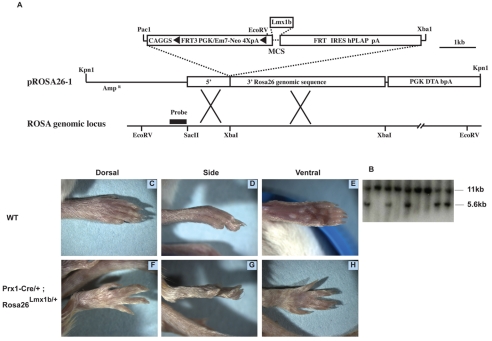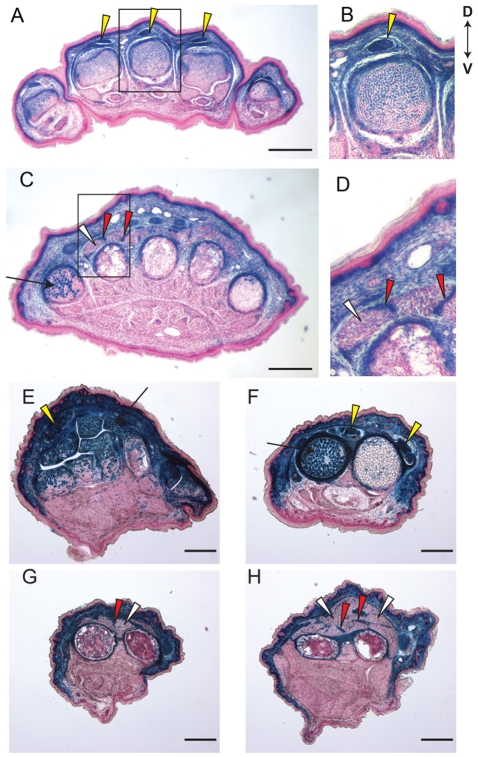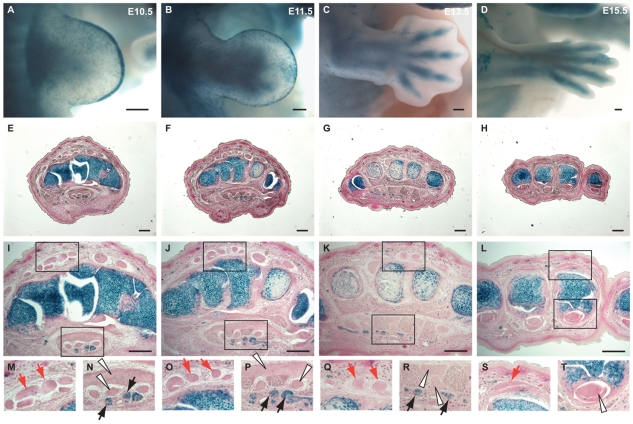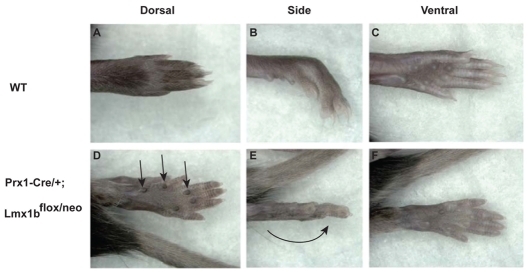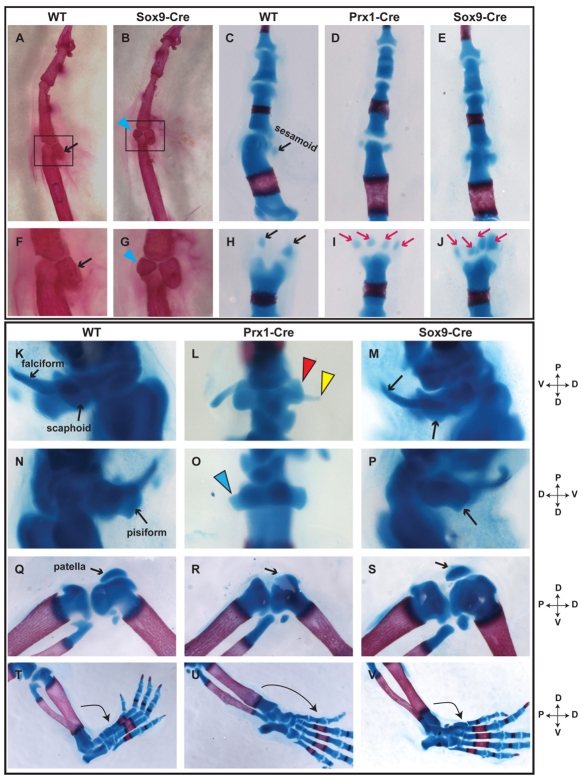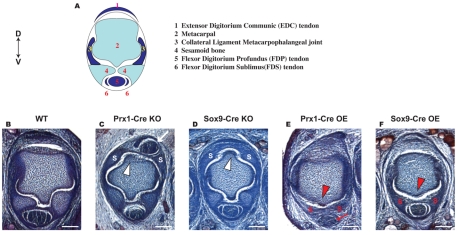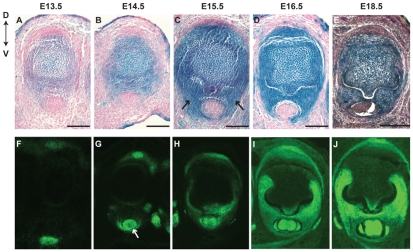Abstract
Integration of muscle, connective tissue and skeletal patterning during development is essential for proper functioning of the musculoskeletal system. How this integration is achieved is poorly understood. There is ample evidence suggesting that skeletal pattern is programmed autonomously, whereas muscle pattern is, for the most part, programmed non-cell-autonomously. Connective tissues depend upon both muscle and skeletal tissues for their proper survival and development. Here, we employed a novel approach to dissect the coordination of musculoskeletal patterning during mouse limb development. Using both conditional gain- and loss-of-function approaches, we selectively deleted or activated the LIM-homeodomain transcription factor Lmx1b in skeletal progenitors using a Sox9-Cre knock-in allele. As Lmx1b is both necessary and sufficient to specify dorsal pattern, this approach allowed us to investigate the effect of selectively deleting or activating Lmx1b in skeletal progenitors on muscle, connective and skeletal tissues during limb development. Our results indicate that whereas Lmx1b activity is required autonomously in skeletal progenitors to direct dorsal pattern, loss or gain of Lmx1b activity in skeletal progenitors has no effect on muscle or connective tissue patterning. Hence, we show for the first time that skeletal and connective tissue patterning can be uncoupled, indicating a degree of autonomy in the formation of the musculoskeletal system.
Keywords: Limb development, Dorsal-ventral patterning, Lmx1b, Mouse
INTRODUCTION
The coordinated movement of animals requires a complex arrangement of muscle, connective and skeletal tissues. In vertebrates, the appendicular (limb) and axial (body) musculature are integrated into a musculoskeletal system by attachment to bones through tendons and by innervations from specific motoneurons from the spinal cord. Upon contraction, body and limb muscles exert force on skeletal elements through tendons, leading to directed movement. Coordinated gross and fine movements are achieved through a stereotyped muscle and tendon pattern, together with appropriate input from the central nervous system.
How the complex arrangement of musculoskeletal tissues is achieved is poorly understood. In principle, each tissue (skeletal, connective or muscle) could have an intrinsic developmental program that directs its patterning. Alternatively, there might be communication between progenitor cells of distinct lineages that directs their patterning in a non-cell-autonomous manner. Several studies have explored this question and it appears that, in general, muscle progenitors are naïve and depend on signals from surrounding tissues to adopt specific arrangements of muscle fibers and eventually a stereotyped adult form (Chevallier et al., 1977; Christ et al., 1977; Jacob, 1980; Kardon et al., 2002). By contrast, skeletal progenitors appear to have a degree of autonomy in that in the absence of muscle, the limb skeleton develops with a normal pattern (Brent et al., 2005). Autonomous versus non-autonomous mechanisms of tendon and ligament patterning have been less extensively studied, with evidence for both autonomous and non-autonomous modes of development.
Studies of mechanisms that coordinate skeletal, muscle and connective tissue patterning are hampered by interactions between progenitor populations that provide survival cues. For example, when skeletal development is arrested using genetic methods, muscle progenitors fail to proliferate at normal levels leading to hypoplastic muscles of abnormal pattern (Brent et al., 2005). Likewise, in chick limb buds in which muscle progenitors have been ablated prior to migration into the limb field, tendon progenitors fail to proliferate and eventually fail to form mature tendon tissues (Kardon, 1998). Hence, because of interactions between musculoskeletal progenitors that are essential for proliferation and survival, the question of how patterning is coordinated in musculoskeletal systems has not been fully addressed.
Ideally, to approach the question of cell autonomy versus non-autonomy in musculoskeletal patterning, one would like a system in which patterning can be manipulated independently of proliferation or survival. Fortunately, in the case of limb development, such a system is available. The LIM-homeodomain transcription factor Lmx1b is expressed in dorsal mesenchymal cells, where it is required to specify dorsal pattern. In Lmx1b mutant mice, all tissues of the limb are affected, resulting in a biventral limb pattern, which is especially apparent in the distal-most portion of the limb, the autopod (Chen et al., 1998). Lmx1b is also able to reprogram ventral limb tissues to adopt a dorsal pattern when it is ectopically expressed in the ventral limb bud (Riddle et al., 1995; Vogel et al., 1995). Importantly, these patterning alterations are not accompanied by increased cell death or decreased overall proliferation, suggesting that interactions between musculoskeletal progenitors that are required for maintaining proper levels of growth and differentiation are not affected by overexpressing or removing Lmx1b activity in limb bud mesenchymal cells.
Here, we report that selective removal of Lmx1b in skeletal progenitor cells results in cell-autonomous defects in dorsal-ventral patterning. Using a Sox9-Cre knock-in allele that directs Cre recombinase expression to skeletal progenitor cells, combined with a conditional allele of Lmx1b, we find that the dorsal-specific pattern of metacarpal bones is replaced with a ventral-specific pattern as seen in the Lmx1b-null mutant. Similarly, ectopic expression of Lmx1b specifically in skeletal progenitors results in a ventral-to-dorsal transformation of metacarpal bone pattern. Despite the robust patterning alterations in skeletal tissues upon Sox9-Cre-mediated activation or inactivation of Lmx1b, a normal morphology of dorsal and ventral tendons is observed in both cases. Hence, our results suggest a cell-autonomous mechanism for skeletal patterning and argue against a role for skeletal tissues in patterning adjacent tendon tissues. Our results are also the first to decouple skeletal and connective tissue patterning, providing insight into mechanisms that coordinate musculoskeletal patterning in general.
MATERIALS AND METHODS
Generation of Rosa26Lmx1b knock-in mice
To generate the targeting vector, a Lmx1b cDNA was subcloned into the pROSA26-CAGGS-floxed-PGK-Neo-IRES-hPLAP vector as schematized in Fig. 4. pROSA26-CAGGS-floxed-PGK-Neo-IRES-hPLAP was modified from pROSA26-PA (Addgene) by inserting a CAGGS-loxP-FRT3-PGK-Neo-4X SV40 poly(A)-loxP-FRT fragment and an IRES-hPLAP (human placental alkaline phosphatase, ALPP) fragment into the XbaI site of pROSA26-PA. Linearized targeting vector was electroporated into RJ2.2 ES cells and correctly targeted clones were identified by Southern blot analysis. Targeted ES cells were injected into blastocysts to generate chimeric mice, which were subsequently bred to transmit the targeted allele through the germline.
Fig. 4.
Generation of the ROSA26Lmx1b allele and phenotype of Lmx1b conditional overexpression (cOE) in limb mesenchyme using Prx1-Cre mice. (A) Targeting strategy. A CAGGS-loxP-PGK-neo-loxP-Lmx1b-IRES-hPLAP fragment was targeted to the endogenous ROSA26 locus. Black arrowhead, loxP site; MCS, multiple cloning site. (B) Southern blot showing that five (5.6 kb band) out of nine ES cell clones are targeted. (C-H) Compared with the wild-type control (C-E), the Prx1 cOE mutant shows a ventral-to-dorsal transformation phenotype: hairs are present on the ventral skin (H) and the ventral flexure is lost (G); dorsal features are unchanged (F).
β-galactosidase staining
Stainings of whole embryos and of frozen limb sections of P0 mice were performed as described (Qiu et al., 2009). For limb sections between E13.5 and E16.5, staining was performed on whole limbs, then the stained samples were dehydrated in an ethanol series from 70%, 80%, 95% to 100%, with at least 15 minutes for each step, cleared in xylene for 15 minutes and then soaked in paraffin with vacuum for 12 hours with two changes. Subsequently, samples were embedded and sectioned at 7 μm and counterstained with Nuclear Fast Red.
Skeletal preparation for adult and newborn mice
Euthanized newborn mice were scalded in water at 68°C for 1 minute, and the skin and internal organs were removed as far as possible. The samples were fixed overnight in 95% ethanol, followed by Alcian Blue (0.015% Alcian Blue in 800 ml 95% ethanol plus 200 ml acetic acid) staining overnight. The stained samples were placed back into 95% ethanol for 2-3 hours and then transferred to 2% KOH for 12-24 hours. The remaining fat was manually removed when the samples were placed in 2% KOH. Before the skeletons fell apart, they were transferred to Alizarin Red solution (0.015% Alizarin Red, 1% KOH, in water) for 1.5 hours. Finally, the skeletons were cleared in 1% KOH/20% glycerol for ~2 days and stored in a 1:1 mixture of glycerol and 95% ethanol. For adult mice, it was not necessary to scald the specimen and the skin and internal organs were removed directly; subsequent steps were as for the newborn.
Mallary's trichrome staining
Limb sections were fixed in HgCl2 solution (5% HgCl2, 5% glacial acetic acid, in water) for 10 minutes, stained in 1% acid fuchsin for 15 seconds, rinsed in water for 2 seconds, transferred into 1% phosphomolybdic acid for 1 minute, and then into Mallory's solution (0.5% Aniline Blue, 2% Orange G, 2% oxalic acid, in water) for 5 minutes. After staining, sections were dehydrated in 95% and 100% ethanol, cleared in xylene and mounted with coverslips using Permount medium (Fisher).
RESULTS
Lmx1b is expressed in skeletal and connective tissue progenitors, but not in muscle progenitors
Although Lmx1b is widely expressed in dorsal mesenchymal cells during early limb bud development, it is not clear whether these Lmx1b-expressing cells contribute to all lineages of the limb. In order to address which progenitors express Lmx1b, we used a genetic strategy to mark Lmx1b-expressing cells early in limb development and follow their fates at later time points. Forelimbs of P0 mice that contain a Lmx1b-Cre knock-in allele (see Fig. S1 in the supplementary material) and a ROSA26 lacZ reporter (Soriano, 1999) were sectioned and stained for β-galactosidase activity. Blue-staining cells represent those that had previously expressed Lmx1b and Cre, thereby recombining the floxed stop cassette at the ROSA26 locus. Strong staining was observed in dorsal mesenchymal cells, as well as in dorsal tendons and in cartilage (Fig. 1A,B). Staining was also observed surrounding muscle bundles, and this is most likely to be muscle connective tissue as we have previously shown that Lmx1b is not expressed in muscle progenitor cells at E11.5 (Schweizer et al., 2004). Hence, Lmx1b is expressed in tendon and skeletal progenitors of the dorsal limb bud as well as in muscle connective tissue progenitors.
Fig. 1.
Fate mapping of Lmx1b-expressing cells. (A-H) X-Gal staining of limb sections of Lmx1bN246K-Cre/+; R26R/+ mice at P0 showing (A) metacarpal-phalangeal joint, (C) metacarpal bone, (E) carpal bone, (F) distal zeugopod, (G) medium zeugopod and (H) proximal zeugopod. β-galactosidase activity is evident in dorsal tissues, such as tendons (yellow arrowhead), muscle connective tissues (red arrowhead) and cartilage cells (arrow), but not in dorsal muscle tissues (white arrowhead). The boxed areas in A and C and enlarged in B and D, respectively. Scale bars: 200 μm. D, dorsal; V, ventral.
Sox9-Cre is active at early stages of limb development and Cre activity is largely restricted to skeletal progenitors
In order to delete Lmx1b in the skeletal lineage, we required a Cre line that is active at times when Lmx1b is expressed and is restricted to the skeletal lineage. A recently described Sox9-Cre knock-in line is currently the best available Cre line for these purposes; however, it has been reported to be active in both skeletal and connective tissue lineages of the developing limb (Akiyama et al., 2002). To examine in more detail the timing and spatial location of Sox9-Cre activity in developing limb buds, we generated embryos that contain Sox9-Cre together with the ROSA26 lacZ reporter and stained embryos for β-galactosidase activity. Sox9-Cre was active in a subset of mesenchymal cells as early as E10.5 and this activity expanded to occupy the presumptive skeletal progenitor territory by E11.5 (Fig. 2A,B). Restricted expression was apparent at E13.5 and E15.5 in whole-mount specimens. Sections of forelimbs at P0 revealed that Sox9 activity in the metacarpal region of the autopod is largely in the cartilage and associated sesamoid bones, although a few scattered mesenchymal cells were positive for β-galactosidase activity. Importantly, at these axial levels, there was little or no staining in tendons. Hence, Sox9-Cre exhibits activity at a time when Lmx1b is expressed in skeletal progenitor cells and its activity is restricted to skeletal progenitor cells in the distal limb.
Fig. 2.
X-Gal staining of Sox9Cre/+; R26R/+ mouse forelimbs. (A-D) Whole-mount staining of forelimb buds or forelimbs at the stages indicated. (E-H) Transverse sections of metacarpal bones at P0, from the most proximal point (E) to the metacarpophalangeal (MP) joint (H). (I-L) Regions of E-H shown at higher magnification. (M-T) The boxed areas from I-L shown at higher magnification. Positive staining is mostly restricted to chondrocytes. Dorsal tendons are not stained (M,O,Q,S, red arrows), nor are most of the ventral tendons (N,P,R,T, white arrowheads). The distinct ventral blue circles are nerves (N,P,R, black arrows). Scale bars: 200 μm.
Conditional deletion and overexpression of Lmx1b in all limb bud mesenchymal cells leads to complete dorsal-ventral transformation
Our approach was to use Cre-mediated gain- and loss-of-function to address the skeletal-specific requirement for Lmx1b in dorsal-ventral limb patterning. We first determined whether conditional deletion of Lmx1b in all limb bud mesenchymal cells recapitulates the null phenotype. Crossing Prx1-Cre (Logan et al., 2002) (Prx1 is also known as Prrx1) with null and floxed alleles of Lmx1b (Ding et al., 2003) yielded mice that exhibited complete dorsal-to-ventral transformations of autopod tissues (Fig. 3). However, unlike the null allele, conditional deletion of Lmx1b in limb bud tissues circumvents a requirement for Lmx1b in the CNS that otherwise leads to perinatal lethality (Chen et al., 1998). To generate a system to conditionally overexpress Lmx1b, we inserted a cassette containing a CAGGS promoter, floxed stop cassette, Lmx1b cDNA, followed by IRES-alkaline phosphatase (to monitor expression) into the ROSA26 locus by homologous recombination in mouse ES cells (Fig. 4). Subsequent generation of chimeras, germline transmission and crossing to Prx1-Cre mice yielded animals that expressed Lmx1b in all limb mesenchymal cells, including ectopically in ventral mesenchyme. Consistent with gain-of-function studies performed with Lmx1b in the chick (Riddle et al., 1995; Vogel et al., 1995), the ectopic expression of Lmx1b in ventral mouse limb bud mesenchyme resulted in a ventral-to-dorsal conversion of ventral tissues.
Fig. 3.
Phenotype of Lmx1b conditional knockout (cKO) in limb mesenchyme using Prx1-Cre mice. (A-C) The hind limb of a wild-type (WT) animal at 3 weeks of age exhibits dorsal-ventral asymmetry in the external structures, such as a high density of hairs on the dorsal side, footpads on the ventral side and digit flexure towards the ventral side. (D-F) In the Prx1 cKO mutant, this dorsal-ventral asymmetry is lost: less hair is seen on the dorsal skin and instead footpads are present (D, arrows), and the ventral flexure of digit disappears (E, arrow); ventral structures are unchanged (F).
Skeletal-specific deletion of Lmx1b results in distal duplication of ventral skeletal elements
Having established that conditional deletion of Lmx1b in all limb bud tissues results in a dorsal-to-ventral transformation, similar to that seen in the Lmx1b-null mutants, we then generated animals that contained Sox9-Cre together with floxed and null alleles of Lmx1b. These mice were born at a normal Mendelian frequency and exhibited no obvious gross abnormalities. Investigation of skeletal pattern, initially by whole-mount Alizarin Red staining, revealed a partial duplication of sesamoid bones at the metacarpophalangeal joint, indicative of a dorsal-to-ventral transformation (Fig. 5). We obtained similar results when using Prx1-Cre. However, whereas Prx1-Cre was effective in generating dorsal-ventral patterning alterations in more proximal tissues, including the wrist and patella, the phenotypes of Sox9-Cre animals were limited to the distal autopod.
Fig. 5.
Skeletal preparation of the limb of wild-type and mutant mice. Skeletal preparations at 4 weeks of age (A,B,F,G) and at P0 (C-E,H-V). (A-J) In the wild type, the sesamoid bone is located at the ventral side of the MP joint (A,F, arrows). In the Sox9 cKO mutant, a dorsal ectopic sesamoid bone appears, sitting in the opposite position to normal (B,G, arrowheads). In the wild type at P0, a pair of sesamoids is located in between phalange and metacarpal (C,H, arrows). However, in Prx1 and Sox9 cKO mutants, two pairs of sesamoids are observed (I,J, arrows). The boxed areas in A and B are enlarged in F and G, respectively. The MP joints in C-E are opened, and the metacarpal bone is removed to show the joint cavity in H-J. (K-V) Wrist (K-P), knee (Q-S) and ankle (T-V). The wild-type animal exhibits visible dorsal-ventral asymmetries, such as falciform, scaphoid and pisiform bones at the ventral wrist, and patella and ankle flexure of the dorsal hind limb (K,N,Q,T, arrows). In the Prx1 cKO mutant, the ventral bones — the scaphoid (L, red arrowhead), falciform (L, yellow arrowhead), pisiform (O, blue arrowhead) — are all duplicated in a dorsal position. However, the dorsal features, patella and dorsal flexure at ankle, are lost (R,U, arrows). All these proximal phenotypes are absent in the Sox9 cKO mutant.
Independent patterning of skeletal and tendon progenitors
To investigate the effects of conditional deletion and overexpression of Lmx1b in more detail, we obtained sections at the metacarpophalangeal joint of wild-type, Prx1-Cre conditional deletion and overexpression, and Sox9-Cre conditional deletion and overexpression forelimbs at P0 and stained with Mallory's trichrome (Fig. 6). In the case of Prx1-Cre conditional deletion (Fig. 6C), we observed dorsal-to-ventral transformation of both skeletal and tendon tissues, similar to that previously observed in Lmx1b-null mutants. Prominent alterations were the transformation of the normally flat dorsal tendon to a round ventral morphology (Fig. 6C, arrow), the presence of dorsal sesamoid bones (Fig. 6C, s), and a dorsal cartilaginous protrusion of the metacarpal (Fig. 6C, arrowhead). By contrast, in the Sox9-Cre conditional deletion mice, we observed a dorsal-to-ventral transformation of the skeletal tissues, whereas the dorsal tendon was unaffected (Fig. 6D).
Fig. 6.
Trichrome staining on P0 forelimb sections at the MP joint. (A) Anatomy of the mature wild-type MP joint. (B-F) Compared with the wild-type forelimb (B), the Prx1 cKO shows a dorsal-to-ventral transformation phenotype in both tendon and skeletal tissues: the dorsal EDC tendon is replaced by ventral FDP and FDS tendons (C, arrow) and the ventral tip structure on the metacarpal bone and the ventral sesamoids are duplicated in dorsal (C, arrowhead and s). Sox9 cKO displays the transformation only in skeletal tissue (D, arrowhead and s). Prx1 cOE shows reduced ventral FDS tendon (E, arrow) and reduced tip of metacarpal and sesamoids (E, arrowhead and s), whereas Sox9 cOE exhibits the reduction only in sesamoids (F, s) and the tip of metacarpal (F, arrowhead). EDC, extensor digitorum communis; FDP, flexor digitorium sublimus; FDS, flexor digitorium profundus; s, sesamoid. Scale bars: 100 μm.
To gain further support for autonomous Lmx1b-dependent limb skeletal patterning, we examined the consequence of conditional ectopic expression of Lmx1b using Prx1-Cre and Sox9-Cre. When Lmx1b was expressed throughout the dorsal and ventral limb bud tissues, we observed a partial ventral-to-dorsal transformation (Fig. 6E) of both tendon and skeletal elements, in which the ventral cartilaginous protrusion was reduced and the ventral tendon was partially converted to a dorsal morphology, with loss of the lateral flexor digitorium profundus (FDS) tendon (Fig. 6E, arrow) and flattening of the normally oval flexor digitorium sublimus (FDP). Consistent with the conditional deletion studies, expression of Lmx1b in both dorsal and ventral skeletal progenitors led to ventral-to-dorsal transformation of skeletal tissues without affecting tendon patterning. Hence, dorsal-ventral skeletal patterning can be uncoupled from tendon patterning.
Developmental timing of dorsal-ventral asymmetry at the metacarpophalangeal joint
The sequence of events that lead to asymmetry of dorsal and ventral limb tendons and skeletal elements has not been examined in detail. In order to define more precisely how asymmetry forms at the metacarpophalangeal joint, we examined the morphogenesis of tendon and skeletal progenitors from E13.5 to E18.5 using a Sox9-Cre/R26 lacZ reporter and Scx-GFP mice (Fig. 7). At E13.5, skeletal progenitors were largely symmetrically distributed along the dorsal-ventral axis with a slight increase in labeling in ventral tissues (Fig. 7A). At this stage, there was also some asymmetry in dorsal and ventral tendons, but not as pronounced as at later stages, and the ventral tendon primordium had not yet split into FDS and FDP tendons. By E14.5, there was a clear asymmetry in dorsal and ventral tendons, while the skeletal progenitors had not yet formed the ventral sesamoid bones or ventral protrusion. However, by E15.5, both the tendon and skeletal primordia were asymmetric, in a form that resembled the final dorsal-ventral asymmetric pattern. Hence, although dorsal-ventral asymmetry may be specified prior to E13.5, the final morphological asymmetries are not fully formed until E14.5-15.5.
Fig. 7.
Formation of the metacarpophalangeal joint and development of the skeletal and tendon components within it. (A-E) Skeletal precursor cells labeled by X-Gal staining on MP joint sections for Sox9Cre/+; R26R/+ embryos at the stages indicated. (F-J) Tendon/ligament progenitors are visualized by green fluorescence on MP joint sections from Scx-GFP/+ transgenic embryos. At E13.5, skeletal and tendon cells are largely symmetrically distributed along dorsal-ventral axis. The dorsal-ventral asymmetry starts to appear because of the presence of the FDS/FDP tendon (G, arrow) from E14.5 and of the ventral sesamoid bone (C, arrows) at E15.5. The whole MP structure is fully developed by E18.5. Scale bars: 100 μm.
DISCUSSION
Cell-autonomous and non-autonomous requirements for Lmx1b in directing dorsal limb pattern
The LIM-homeodomain transcription factor Lmx1b is both necessary and sufficient to instruct dorsal fates during limb development (Chen et al., 1998; Riddle et al., 1995; Vogel et al., 1995). Our studies provide evidence that Lmx1b is expressed in skeletal progenitors and acts autonomously in these tissues to direct their dorsal pattern. Since Lmx1b is not expressed in muscle progenitors (Schweizer et al., 2004), yet muscle pattern is affected in Prx1-Cre conditional knockout mutants (see Fig. S4 in the supplementary material), its activity on muscle must be non-cell-autonomous. In this study, we were not able to address whether skeletal Lmx1b expression is required for muscle patterning as the phenotypes we observed were limited to distal tissues, where dorsal-ventral muscle asymmetry is not evident. However, our fate-mapping studies indicate that Lmx1b is expressed in muscle connective tissue and it is possible that conditional deletion of Lmx1b in muscle connective tissue progenitors leads to dorsal-to-ventral transformation of muscle tissues. Although Lmx1b is required in skeletal progenitors, removal of Lmx1b activity in these tissues does not affect tendon patterning, at least in the distal limb bud. Hence, our results indicate, for the first time, that tendon and skeletal patterning can be uncoupled and suggest a relative degree of autonomy in the patterning of these two tissues. It has been demonstrated that tendon controls bone ridge patterning at the proximal limb (Blitz et al., 2009), and this, together with our results, indicate that autonomous and non-autonomous mechanisms coexist along the proximal-distal axis during limb pattern formation.
Skeletal transformations are limited to distal tissues in Sox9-Cre-mediated conditional deletion and expression of Lmx1b
Mice that lack Lmx1b exhibit dorsal-to-ventral transformations of all limb tissues at least to the mid-zeugopodal level (Chen et al., 1998). Lmx1b is required in more proximal tissues, as evidenced by its role in dorsal-ventral pathfinding by motoneurons, a process that requires the specification of a proximal branch point at the base of the limb bud on or around E10.5 (Kania and Jessell, 2003). Additionally, a feature of attenuation of Lmx1b function is a reduction of the patella in humans and its complete loss in homozygous mutant mice (Chen and Johnson, 1999; Dreyer et al., 1998). Therefore, Lmx1b activity is required in both proximal and distal limb bud tissues, although there might be a greater requirement for Lmx1b function in distal tissues.
In contrast to the effect of complete deletion of Lmx1b, either in the null allele or using conditional Prx1-Cre strategies, removal of Lmx1b in skeletal progenitors results in patterning alterations that are limited to the digits. Several factors might account for this difference. It is possible that skeletal progenitors only require Lmx1b activity in the digits and that Lmx1b acts non-autonomously in more proximal regions. This is unlikely, as skeletal patterning is generally thought to be autonomous. A second, more likely, possibility is that deletion of Lmx1b with Sox9-Cre occurs too late to have an effect on proximal limb tissues. In skeletal progenitors, Lmx1b expression is downregulated upon condensation and is not detectible in cartilaginous primordia (Dreyer et al., 2004). Therefore, for Sox9-Cre to recombine the loxP sites at the Lmx1b locus at a time when Lmx1b is exerting its patterning effects, this must occur prior to the differentiation of cartilaginous progenitors. We do observe recombination as early as E11.5 using Sox9-Cre and Prx1-Cre (see Fig. S2 in the supplementary material), and ectopic expression at similar stages (see Fig. S3 in the supplementary material), although recombination and ectopic expression are more complete by E13.5 (see Figs S2 and S3 in the supplementary material). Since limb development is a progressive process from proximal to distal (Johnson and Tabin, 1997), the fact that we observe only distal phenotypes upon conditional loss and overexpression of Lmx1b using Sox9-Cre might indicate that Lmx1b is deleted at a time when its function can be revealed only in the distal-most limb tissues. This possibility is supported by the timing of differentiation of skeletal elements at the metacarpophalangeal joint. Currently, we are examining temporal requirements for Lmx1b function using tamoxifen-regulated conditional deletion and ectopic expression strategies (Hayashi and McMahon, 2002). Such studies should reveal at what times Lmx1b is required for dorsal-ventral specification along the proximal-distal axis.
Coordination of limb musculoskeletal patterning
Our results indicate that Lmx1b-dependent skeletal patterning is autonomous. Whether Lmx1b is required in tendon primordia to direct tendon pattern is not known. We have crossed Scx-Cre mice that express Cre recombinase in tendon primordia to Lmx1b floxed mice, but did not observe any morphological alteration in tendon or skeletal pattern (data not shown). It might be that Lmx1b activity is not required in tendons, but more likely reflects an inability to delete Lmx1b in tendon primordia at an early time point, a limitation of current reagents. Nevertheless, our results suggest a degree of autonomy in the patterning of skeletal tissues and that alteration of skeletal patterning can occur independently of connective tissue patterning. Whether this is the case for muscle has yet to be determined. In any event, our results support an autonomous mode of musculoskeletal patterning in which each tissue acquires pattern independently. We speculate that connective tissue is patterned in a similar manner to the cartilaginous primordia in a cell-autonomous manner. Muscle, by contrast, is patterned non-cell-autonomously, most likely through interaction with muscle connective tissue. Approaches to address this issue include generating mice that express Cre recombinase in muscle connective tissues and the analysis of marked Lmx1b mutant clones in the developing limb bud.
Control of dorsal-ventral limb patterning by Lmx1b
Lmx1b functions in a similar manner to selector genes in Drosophila. In previous studies, we have shown that Lmx1b is required to specify murine dorsal limb pattern (Chen et al., 1998). Here, we show that as in the avian embryo, murine Lmx1b is sufficient to redirect ventral limb bud mesenchyme to a dorsal fate. In addition to its role in specifying dorsal pattern, Lmx1b also functions to maintain a dorsal mesenchyme compartment that is defined by the Lmx1b expression domain (Arques et al., 2007; Pearse et al., 2007; Qiu et al., 2009). Hence, Lmx1b is required to both specify pattern and to maintain compartment boundaries, in analogy with selector genes, such as engrailed, in the Drosophila wing imaginal disc (Mann and Carroll, 2002). How Lmx1b, or any other vertebrate selector gene, functions to either specify pattern or to maintain compartment boundaries is not understood at the molecular level. However, it is likely that Lmx1b controls pattern in a manner analogous to that defined by the selector genes vestigial and scalloped in the wing imaginal disc, where these genes modify the responsiveness of target promoters to cell-intrinsic and extrinsic signals (Halder et al., 1998). In this manner, Lmx1b would function essentially as a binary signal: on in dorsal limb mesenchyme and off in ventral limb bud mesenchyme. This binary signal would then interface with a default ventral program and alter the responsiveness of target genes in dorsal tissues. At present, no direct targets of Lmx1b have been described in the developing limb bud, although several genes have been identified, the expression pattern of which is dependent on Lmx1b (Dreyer et al., 2004; Krawchuk and Kania, 2008). Clearly, the identification of direct Lmx1b targets will provide insight into how Lmx1b controls dorsal limb pattern. Moreover, our results suggest that these targets might in fact be distinct in different limb progenitor tissues. For example, if Lmx1b is required in muscle connective tissue to pattern muscle in a non-cell-autonomous manner, then at least some of the relevant targets in muscle connective tissue are likely to be cell surface or secreted factors. Likewise, Lmx1b is autonomously required in skeletal progenitors, and its direct targets in those progenitors are likely to be responsible for stabilization or modulation of the pattern of cartilaginous progenitor cells. In any event, the results of our current study will provide a framework for understanding the developmental logic of dorsal-ventral patterning controlled by Lmx1b.
Supplementary Material
Acknowledgements
We thank Haruhiko Akiyama for providing the Sox9-Cre knock-in mice and Jan Parker-Thornburg for assistance in generating targeted mouse lines. This study was supported by grant HD052785 from the NIH to R.L.J. Deposited in PMC for release after 12 months.
Footnotes
Competing interests statement
The authors declare no competing financial interests.
Supplementary material
Supplementary material for this article is available at http://dev.biologists.org/lookup/suppl/doi:10.1242/dev.045237/-/DC1
References
- Akiyama H., Chaboissier M. C., Martin J. F., Schedl A., de Crombrugghe B. (2002). The transcription factor Sox9 has essential roles in successive steps of the chondrocyte differentiation pathway and is required for expression of Sox5 and Sox6. Genes Dev. 16, 2813-2828 [DOI] [PMC free article] [PubMed] [Google Scholar]
- Arques C. G., Doohan R., Sharpe J., Torres M. (2007). Cell tracing reveals a dorsoventral lineage restriction plane in the mouse limb bud mesenchyme. Development 134, 3713-3722 [DOI] [PubMed] [Google Scholar]
- Blitz E., Viukov S., Sharir A., Shwartz Y., Galloway J. L., Pryce B. A., Johnson R. L., Tabin C. J., Schweitzer R., Zelzer E. (2009). Bone ridge patterning during musculoskeletal assembly is mediated through SCX regulation of Bmp4 at the tendon-skeleton junction. Dev. Cell 17, 861-873 [DOI] [PMC free article] [PubMed] [Google Scholar]
- Brent A. E., Braun T., Tabin C. J. (2005). Genetic analysis of interactions between the somitic muscle, cartilage and tendon cell lineages during mouse development. Development 132, 515-528 [DOI] [PubMed] [Google Scholar]
- Chen H., Johnson R. L. (1999). Dorsoventral patterning of the vertebrate limb: a process governed by multiple events. Cell Tissue Res. 296, 67-73 [DOI] [PubMed] [Google Scholar]
- Chen H., Lun Y., Ovchinnikov D., Kokubo H., Oberg K. C., Pepicelli C. V., Gan L., Lee B., Johnson R. L. (1998). Limb and kidney defects in Lmx1b mutant mice suggest an involvement of LMX1B in human nail patella syndrome. Nat. Genet. 19, 51-55 [DOI] [PubMed] [Google Scholar]
- Chevallier A., Kieny M., Mauger A. (1977). Limb-somite relationship: origin of the limb musculature. J. Embryol. Exp. Morphol. 41, 245-258 [PubMed] [Google Scholar]
- Christ B., Jacob H. J., Jacob M. (1977). Experimental analysis of the origin of the wing musculature in avian embryos. Anat. Embryol. (Berl.) 150, 171-186 [DOI] [PubMed] [Google Scholar]
- Ding Y. Q., Marklund U., Yuan W., Yin J., Wegman L., Ericson J., Deneris E., Johnson R. L., Chen Z. F. (2003). Lmx1b is essential for the development of serotonergic neurons. Nat. Neurosci. 6, 933-938 [DOI] [PubMed] [Google Scholar]
- Dreyer S. D., Zhou G., Baldini A., Winterpacht A., Zabel B., Cole W., Johnson R. L., Lee B. (1998). Mutations in LMX1B cause abnormal skeletal patterning and renal dysplasia in nail patella syndrome. Nat. Genet. 19, 47-50 [DOI] [PubMed] [Google Scholar]
- Dreyer S. D., Naruse T., Morello R., Zabel B., Winterpacht A., Johnson R.L., Lee B., Oberg K. C. (2004). Lmx1b expression during joint and tendon formation: localization and evaluation of potential downstream targets. Gene Expr. Patterns 4, 397-405 [DOI] [PubMed] [Google Scholar]
- Halder G., Polaczyk P., Kraus M. E., Hudson A., Kim J., Laughon A., Carroll S. (1998). The Vestigial and Scalloped proteins act together to directly regulate wing-specific gene expression in Drosophila. Genes Dev. 12, 3900-3909 [DOI] [PMC free article] [PubMed] [Google Scholar]
- Hayashi S., McMahon A. P. (2002). Efficient recombination in diverse tissues by a tamoxifen-inducible form of Cre: a tool for temporally regulated gene activation/inactivation in the mouse. Dev. Biol. 244, 305-318 [DOI] [PubMed] [Google Scholar]
- Jacob H. J., Christ B. (1980). On the formation of muscular pattern in the chick limb. In Teratology of the Limbs: Fourth Symposium on Prenatal Development (ed. Merker H.-J., Nau H., Neubert D.), p89 Berlin: Walter De Gruyter and Company; [Google Scholar]
- Johnson R. L., Tabin C. J. (1997). Molecular models for vertebrate limb development. Cell 90, 979-990 [DOI] [PubMed] [Google Scholar]
- Kania A., Jessell T. M. (2003). Topographic motor projections in the limb imposed by LIM homeodomain protein regulation of ephrin-A:EphA interactions. Neuron 38, 581-596 [DOI] [PubMed] [Google Scholar]
- Kardon G. (1998). Muscle and tendon morphogenesis in the avian hind limb. Development 125, 4019-4032 [DOI] [PubMed] [Google Scholar]
- Kardon G., Campbell J. K., Tabin C. J. (2002). Local extrinsic signals determine muscle and endothelial cell fate and patterning in the vertebrate limb. Dev. Cell 3, 533-545 [DOI] [PubMed] [Google Scholar]
- Krawchuk D., Kania A. (2008). Identification of genes controlled by LMX1B in the developing mouse limb bud. Dev. Dyn. 237, 1183-1192 [DOI] [PubMed] [Google Scholar]
- Logan M., Martin J. F., Nagy A., Lobe C., Olson E. N., Tabin C. J. (2002). Expression of Cre recombinase in the developing mouse limb bud driven by a Prxl enhancer. Genesis 33, 77-80 [DOI] [PubMed] [Google Scholar]
- Mann R. S., Carroll S. B. (2002). Molecular mechanisms of selector gene function and evolution. Curr. Opin. Genet. Dev. 12, 592-600 [DOI] [PubMed] [Google Scholar]
- Pearse R. V., II, Scherz P. J., Campbell J. K., Tabin C. J. (2007). A cellular lineage analysis of the chick limb bud. Dev. Biol. 310, 388-400 [DOI] [PMC free article] [PubMed] [Google Scholar]
- Qiu Q., Chen H., Johnson R. L. (2009). Lmx1b-expressing cells in the mouse limb bud define a dorsal mesenchymal lineage compartment. Genesis 47, 224-233 [DOI] [PubMed] [Google Scholar]
- Riddle R. D., Ensini M., Nelson C., Tsuchida T., Jessell T. M., Tabin C. (1995). Induction of the LIM homeobox gene Lmx1 by WNT7a establishes dorsoventral pattern in the vertebrate limb. Cell 83, 631-640 [DOI] [PubMed] [Google Scholar]
- Schweizer H., Johnson R. L., Brand-Saberi B. (2004). Characterization of migration behavior of myogenic precursor cells in the limb bud with respect to Lmx1b expression. Anat. Embryol. (Berl.) 208, 7-18 [DOI] [PubMed] [Google Scholar]
- Soriano P. (1999). Generalized lacZ expression with the ROSA26 Cre reporter strain. Nat. Genet. 21, 70-71 [DOI] [PubMed] [Google Scholar]
- Vogel A., Rodriguez C., Warnken W., Izpisua Belmonte J. C. (1995). Dorsal cell fate specified by chick Lmx1 during vertebrate limb development. Nature 378, 716-720 [DOI] [PubMed] [Google Scholar]
Associated Data
This section collects any data citations, data availability statements, or supplementary materials included in this article.



